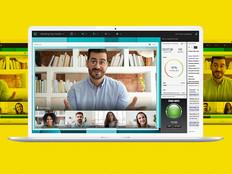EDUCAUSE 2018: 6 Culture Changes to Pave the Way for Digital Transformation
IT security pros often say that the best defense requires three components: technology, processes and people. The same is true of most organizational environments, especially when it comes to creating a healthy, innovative culture. When Steven Burrell came to Northern Arizona University two years ago, changing culture was one of his first priorities.
JOIN THE CONVERSATION: Follow @EdTech_HigherEd on Twitter for continued EDUCAUSE 2018 coverage!
NAU’s CIO and vice president of IT discussed his strategy in “Building a Digital Transformation Culture with Microsoft at Northern Arizona University” on Wednesday at the EDUCAUSE 2018 conference in Denver.
When Burrell arrived at NAU, he found many of the same challenges that hamper cultures everywhere: silos, risk avoidance when it came to shaking up the status quo, a reactive stance to innovation instead of a proactive one and a tendency to let perfection get in the way of progress.
Shifting his team to a new culture wasn’t always easy, Burrell said — some faculty, for example, pushed back against a centralized IT model because they were used to each department having its own IT staff — but other stakeholders, including students, welcomed changes that brought consistency to classroom technology and quicker rollout of new services.
Two years later, Burrell said, NAU’s IT culture reflects six building blocks that support a digital transformation culture.
1. Drive out Complexity with a Simple Organizational Structure
Create clear and simple governance, Burrell advised. When he came to NAU, “there was a history of things being bounced around with no clear authority and decision-making.”
Increasing centralization, moving tactical decision-making to the front lines and clearly designating project parameters helped to clarify goals and timelines. “We’ve got good, capable people, so we try to drive a lot of those tactics to the front lines as best we can,” Burrell said.
A new governance structure included a high-level group of senior leaders at the top, all the way down to advisory councils populated by students, faculty and researchers.
2. Consolidate IT and Focus Resources to Optimize Efficiency
As many IT leaders are doing, Burrell also evaluated which activities were performed on campus that didn’t necessarily have to be, together with which IT skills his team most needed. With partners such as Microsoft and Dell, for example, it was possible to move certain areas to a services model.
In part, he said, that was made possible by a staff reduction, achieved through attrition and turnover, that freed up resources. “In doing so, we had to rethink the skills we needed going forward,” Burrell said. “How do I pivot savings in personnel costs back over to services, or what are the new skill sets I need to hire?”
MORE FROM EDTECH: Read about some of the new ways universities can use the Internet of Things!
3. Create Plans for the Short- and Long-term
Coming out of a decentralized model, Burrell worked to shore up a more consistent user experience across the university. That included tools such as Office 365 Enterprise E5, Skype for Business and other tools in the Microsoft suite, together with a process shift that allowed more short-term wins. A quarterly review of projects in process, supported by a project management framework, helped staff focus on outcomes and timelines.
Burrell also worked to create more staff opportunities for discovery, knowledge transfer with his Microsoft support team and a stronger partner relationship. Looking down the road at technologies such as artificial intelligence and the Internet of Things, he said, “Knowing these would be important to us in the future, we also knew our partner Microsoft would be able to get us there.”
4. Stimulate IT Team Members to Share Innovative Ideas
Burrell said he’s not shy about looking around for great ideas, and he encourages his team to do the same. “Can we emulate something or someone? We borrow all sorts of ideas,” he said, even though previously, “that was not part of the culture.”
He’s also big on asking one specific question that helps to zero in on issues needing attention: “We ask ourselves, ‘Is the problem we’re facing here really the problem?’” Often, he said, a perceived conflict stems from an underlying issue, such as a policy, process, a territorial concern, a reluctance to give up control or a need to learn new skills.
5. IT Leaders Don't Need to Reinvent to Make a Meaningful Difference
The need to align IT resources with strategic initiatives is familiar to many campus CIOs, and part of that depends on the ability to translate capabilities into outcomes, Burrell said. His approach in making a case to senior leaders, he said, is to establish clear connections between the deployment of resources and their impact on student success.
“When I can put that asset in the cloud, let someone else run it and pivot that person to a meaningful skill set or a relationship in the university that’s going to allow students to be more successful, now I’ve got strategic alignment,” he said.
One of Burrell’s initiatives was to redeploy open positions into business analyst roles that engage NAU departments about their business needs. “It was a business conversation, not a technical conversation,” he noted.
That was a big shift for an IT department that had traditionally been inward-facing. However, adding a layer of outward engagement increased interaction between IT and campus departments, which helps to achieve buy-in for initiatives and ensures that IT projects deliver the support stakeholders need.
6. Recognize the Importance of Investing in People
All along the way, Burrell said, his aim was to invest in people first — both their soft skills and technical ones. “If you want to create the change, you have to really start with the people side of things,” he said. That included communication, collaboration and team-building, all defined around the strategic initiative of student success.
Nowadays, he said, “Change is our steady state. We seek innovation in everything.”
To stay up to date on all of the news and ideas coming out of EDUCAUSE, follow EdTech's coverage on the EDUCAUSE 2018 conference hub.









